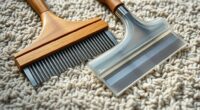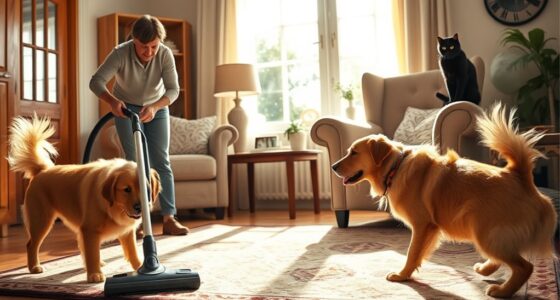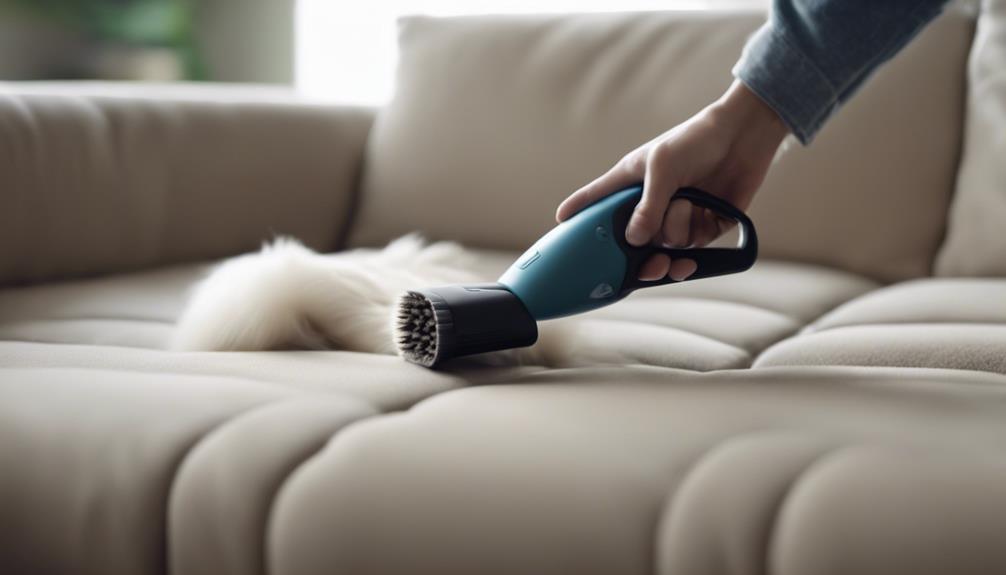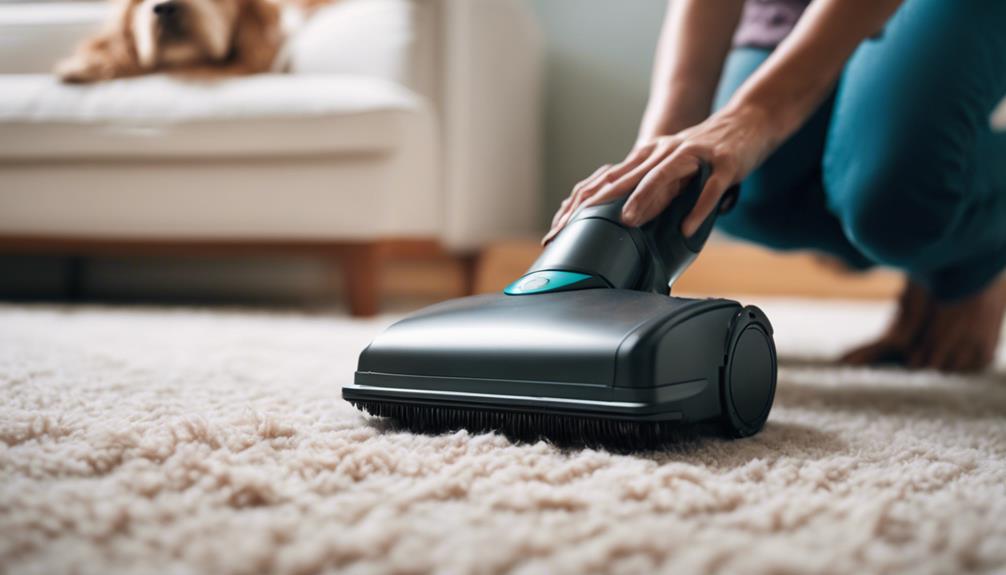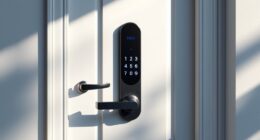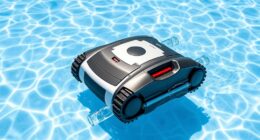To remove pet hair from upholstery and curtains, start by dampening rubber gloves and running them over the surfaces to create static, pulling the hair into clumps. Use a lint roller for quick results, or a vacuum cleaner with a brush attachment for a thorough clean. Washing curtains with fabric softener can reduce static and hair clinginess. For best results, combining these methods and maintaining regular cleaning will help keep your space hair-free; discover more effective tips as you continue.
Key Takeaways
- Use dampened rubber gloves or lint rollers to quickly lift pet hair from upholstery and curtains.
- Vacuum with brush attachments or pet hair removal tools for deep cleaning of fabric surfaces.
- Shake or vacuum curtains regularly to dislodge accumulated pet hair.
- Wash curtains with fabric softener to reduce static and hair clinginess.
- Maintain furniture with washable slipcovers and brush pets regularly to minimize hair buildup.

Have you ever wondered how to keep your home free of pet hair? It’s a common struggle, especially when your furry friends love curling up on your upholstery and draping themselves over curtains. The good news is, with the right pet hair removal techniques and effective pet hair tools, you can maintain a clean, hair-free environment without much hassle. The key lies in understanding which tools work best and how to use them efficiently.
First, focus on the surfaces that attract the most hair—upholstery and curtains. These areas tend to trap pet hair due to their fabric textures and static charges. To start, invest in some effective pet hair tools like rubber gloves, lint rollers, or specially designed pet hair removers. Rubber gloves are surprisingly versatile; simply dampen a glove and run your hand over the fabric. The rubber creates static and friction, pulling pet hair away and into clumps that you can easily pick up. This method is quick, inexpensive, and effective for spot cleaning. Lint rollers are another handy tool; just roll them over your upholstery and curtains to lift hair effortlessly. Keep a stash nearby for quick touch-ups, especially after your pet has been lounging.
Focus on upholstery and curtains; use rubber gloves and lint rollers for quick pet hair removal.
If you prefer a more thorough cleaning, consider using a vacuum cleaner equipped with a brush attachment designed for upholstery and curtains. Many modern vacuums come with pet hair removal features that make the process smoother. Use slow, deliberate strokes to cover the entire surface area, ensuring you dislodge hair from deep within the fibers. For curtains, gently shake or vacuum them while they’re still hanging, or remove and wash them if possible. Washing curtains with a fabric softener can help reduce static and make pet hair less clingy in the future. Additionally, understanding narcissistic behaviors such as projection or gaslighting can help you better deal with emotional stress caused by difficult family dynamics, if relevant to your household environment.
In addition to tools, regular maintenance plays a vital role. Frequent vacuuming of upholstery and curtains prevents pet hair buildup, making cleaning easier each time. Consider brushing your pets regularly to reduce the amount of loose hair that ends up on your furniture. Also, placing washable slipcovers on sofas and chairs can contain hair and make cleanup more manageable—just toss them in the wash when needed.
Frequently Asked Questions
Can I Use a Lint Roller on Delicate Fabrics?
Yes, you can use a lint roller on delicate fabrics, but do so carefully. Gently press the lint roller onto the fabric, avoiding excessive pressure that could damage the material. Use light, even strokes to remove pet hair without pulling or tearing the fabric. Make sure to choose a lint roller with gentle adhesive to protect delicate surfaces, and test it on a small, hidden area first to guarantee it won’t cause harm.
How Often Should I Clean My Upholstery to Prevent Pet Hair Buildup?
Think of your upholstery as a garden that needs regular tending. You should clean it weekly to prevent pet hair buildup, keeping it fresh and inviting. Incorporate this into your furniture maintenance routine, just like pet grooming routines, to reduce hair shedding. Regular vacuuming and quick spot cleans not only preserve your furniture but also show your pets you care—making your home a cozy haven for everyone.
Are There Eco-Friendly Methods to Remove Pet Hair?
Yes, you can use natural remedies and DIY solutions to remove pet hair eco-friendly. Try dampening a microfiber cloth or rubber gloves and running them over your upholstery and curtains; the pet hair sticks to these surfaces easily. You could also sprinkle baking soda, let it sit, then vacuum it up. These methods are effective, safe for the environment, and avoid harsh chemicals, making cleaning more sustainable.
Will Vacuuming Damage Sensitive Fabrics or Curtains?
Vacuuming can cause vacuum damage if you’re not careful, especially with sensitive fabrics or delicate curtains. To safeguard your fabrics’ sensitivity, use a vacuum with gentle suction settings and a soft brush attachment. Test a small, discreet area first to ensure no damage occurs. Regular, cautious vacuuming helps remove pet hair without compromising your curtains or upholstery, keeping them clean and undamaged.
How Do I Remove Pet Hair From Textured or Patterned Upholstery?
To remove pet hair from textured fabrics or patterned upholstery, use a rubber gloves or a damp microfiber cloth to gently lift hair from the surface. For stubborn hair, try a soft-bristled brush or a pet hair removal tool designed for textured surfaces. Regularly vacuum with a brush attachment to prevent buildup. These methods help keep your textured and patterned upholstery clean without damaging the fabric.
Conclusion
Removing pet hair from your upholstery and curtains might seem tricky, but with the right tools and a little patience, you can keep your home hair-free. Did you know that the average pet sheds about 40 pounds of fur in a lifetime? That’s a lot of hair to manage! Staying consistent with your cleaning routine not only keeps your space looking tidy but also creates a healthier environment for you and your pets. Keep at it—you’ve got this!

